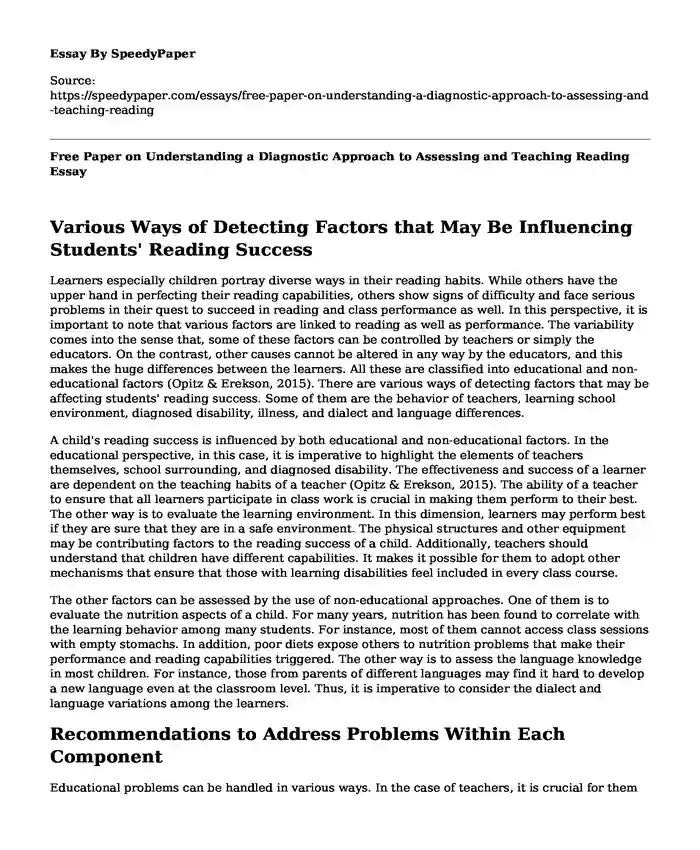Various Ways of Detecting Factors that May Be Influencing Students' Reading Success
Learners especially children portray diverse ways in their reading habits. While others have the upper hand in perfecting their reading capabilities, others show signs of difficulty and face serious problems in their quest to succeed in reading and class performance as well. In this perspective, it is important to note that various factors are linked to reading as well as performance. The variability comes into the sense that, some of these factors can be controlled by teachers or simply the educators. On the contrast, other causes cannot be altered in any way by the educators, and this makes the huge differences between the learners. All these are classified into educational and non-educational factors (Opitz & Erekson, 2015). There are various ways of detecting factors that may be affecting students' reading success. Some of them are the behavior of teachers, learning school environment, diagnosed disability, illness, and dialect and language differences.
A child's reading success is influenced by both educational and non-educational factors. In the educational perspective, in this case, it is imperative to highlight the elements of teachers themselves, school surrounding, and diagnosed disability. The effectiveness and success of a learner are dependent on the teaching habits of a teacher (Opitz & Erekson, 2015). The ability of a teacher to ensure that all learners participate in class work is crucial in making them perform to their best. The other way is to evaluate the learning environment. In this dimension, learners may perform best if they are sure that they are in a safe environment. The physical structures and other equipment may be contributing factors to the reading success of a child. Additionally, teachers should understand that children have different capabilities. It makes it possible for them to adopt other mechanisms that ensure that those with learning disabilities feel included in every class course.
The other factors can be assessed by the use of non-educational approaches. One of them is to evaluate the nutrition aspects of a child. For many years, nutrition has been found to correlate with the learning behavior among many students. For instance, most of them cannot access class sessions with empty stomachs. In addition, poor diets expose others to nutrition problems that make their performance and reading capabilities triggered. The other way is to assess the language knowledge in most children. For instance, those from parents of different languages may find it hard to develop a new language even at the classroom level. Thus, it is imperative to consider the dialect and language variations among the learners.
Recommendations to Address Problems Within Each Component
Educational problems can be handled in various ways. In the case of teachers, it is crucial for them to understand the disparities that exist among the learners and ensure that none of them is left unattended by the teacher (Opitz & Erekson, 2015). Some of the ways are to use learning materials that are familiar to the learners. The other way to address the learning environment is to ensure that learners have access to the required learning materials such as magazines. In addition, there should have proper plans that provide that those with disabilities in learning are well catered for at all times.
Non-educational problems cannot be left out. To deal with nutrition problems, schools should offer meal programs to ensure that learners have access to food that is healthy (Crosnoe, Bonazzo, & Wu, 2015). In addition, those from multi-lingual families should be exposed to sessions that improve their ability to know new languages. Some of these ways are to buying new novels, magazines, and television programs.
References
Crosnoe, R., Bonazzo, C., & Wu, N. (2015). Healthy learners: A whole child approach to reducing disparities in early education. New York: Teachers College Press.
Opitz, M. F, & Erekson, J. A. (2015). Understanding, assessing, and teaching reading: A diagnostic approach (7th Edition). Boston, MA: Pearson
Cite this page
Free Paper on Understanding a Diagnostic Approach to Assessing and Teaching Reading. (2022, Jul 12). Retrieved from https://speedypaper.net/essays/free-paper-on-understanding-a-diagnostic-approach-to-assessing-and-teaching-reading
Request Removal
If you are the original author of this essay and no longer wish to have it published on the SpeedyPaper website, please click below to request its removal:
- Political Science Essay Example on Anti-imperialism
- Free Essay on How Poverty Affects Children Physically
- Report on Big Data Analytics with Hive, Free Example
- Free Essay on the Essence of Man According to Plato and Sartre
- Essay Sample: Why Animal life Matters
- Free Essay - the Rio Grande River
- Free Essay. Effect of Music Education on the Brain and Cognitive Abilities
Popular categories





